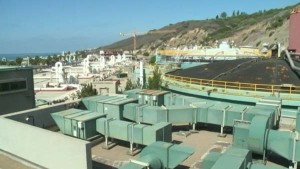
By Jon Fern, staff writer for Save The Water™ | November 25, 2014
Ongoing industrial activity in Canada has caused aquatic acid levels to rise to such an extent that calcium availability has plummeted in local lakes, especially those of Ontario, according to new research. This had led to an explosion of jelly-coated plankton populations that are now crashing food webs and clogging water supply filters.
Dr Adam Jeziorski and his research team from the Department of Biology, Queen’s University, Kingston, Ontario published their findings in the Proceedings of the Royal Society B. Entitled “The Jellification of North Temperate Lakes”, their paper argues that acidification from industial processes, such as oil production, is having a direct impact on aquatic organisms heavily reliant on calcium, in particular members of the Daphnia genus, the water fleas that are among the dominant planktonic species of these lakes.
Without the calcium levels necessary for optimal biological functioning, Daphnia struggle to reproduce, and are especially vulnerable to predation. By consuming less algae, the calcium-depleted water fleas also leave the door open to competitors.
Unfortunately, the competition is making the most of the situation. A jelly-covered organism called Holopedium is quickly taking Daphnia’s place as the dominant form of plankton in the affected lakes. Holopedium requires less calcium than Daphnia, meaning that they are well placed to take advantage of the acidification of the Ontario lakes.
This is not a new phenomenon: lakes in this part of the world have been affected by Holopedium blooms for at least thirty years. The hardest hit water bodies are currently those in Ontario, where an invasive species of spiny water flea has been preying on the native Daphnia, further diminishing its numbers and aiding the Holopedium takeover.
In fact, the situation is so bad, Jeziorski et al. have estimated that on average, populations of Holopedium in the lakes of the Ontario province have doubled in the ten-year period between the mid-Eighties and Nineties, with the effects of disrupting food chains and jamming up drinking water filtration systems. Since the lakes are used not only for commercial fishing but also as the main source of drinking water for many residents, the Holopedium explosion is having a devastating impact on the health and economies of local communities.
The paper’s co-author Andrew Tanentzap, stated: “As calcium declines, the increasing concentrations of jelly in the middle of these lakes will reduce energy and nutrient transport right across the food chain, and will likely impede the withdrawal of lake water for residential, municipal and industrial uses.”
“In Ontario, 20% of government-monitored drinking water systems now come from landscapes containing lakes with depleted calcium concentrations that favour Holopedium, and this is only set to increase.”
Industrial processes in the area are largely to blame for the calcium depletion: when atmospheric acid is deposited in soil, it displaces calcium. Since the affected soil drains into the lakes via surface water runoff, the source of calcium is being lost. Tanentzap suggests that “pollution control may have stopped acid deposits in the landscape, but it’s only now that we are discovering the damage wasn’t entirely reversed.”
And it’s not a situation that will be easily remedied, either. Dr Tanentzap said, “It may take thousands of years to return to historic lake water calcium concentrations solely from natural weathering of surrounding watersheds. In the meanwhile, while we’ve stopped acid rain and improved the pH of many of these lakes, we cannot claim complete recovery from acidification. Instead, we may have pushed these lakes into an entirely new ecological state.”
It remains to be seen whether efforts to reverse the ecological damage done by industrial acidification will be successful. Remedies could include mechanical filtration of the lake surface, the artificial increasing of Daphnia numbers, and the addition of calcium to the affected water bodies. Whatever the method used to correct the situation, it would be worth remembering that every action taken in the natural world can have wide-reaching and unpredictable consequences, such as those that occurred in the lakes of Ontario as a result of industrialization.
References
Estes, A., 2014. Some of Canada’s Lakes Are Turning Into Jelly Thanks to Acid Rain. Gizmodo. https://gizmodo.com/acid-rain-is-turning-canadas-lakes-into-jelly-1660627061 Accessed 25th November 2014.
Feltman, R., 2014. Industrial pollution is turning lakes into ‘jelly’. The Washington Post. https://www.washingtonpost.com/news/speaking-of-science/wp/2014/11/19/industrial-pollution-is-turning-lakes-into-jelly/?utm_term=.846c6c2e4e7f Accessed 25th November 2014.
Jeziorski, A., et al., 2014. The jellification of north temperate lakes. Proceedings of the Royal Society B. https://royalsocietypublishing.org/doi/full/10.1098/rspb.2014.2449. Accessed 25th November 2014.
Uncredited, 2014. Calcium loss turning lakes into ‘jelly’. PhysOrg. http://phys.org/news/2014-11-calcium-loss-lakes-jelly.html Accessed 25th November 2014.
Uncredited, 2014. Effects of Acid Rain. Environmental Protection Agency website. https://www.epa.gov/acidrain/effects-acid-rain Accessed 25th November 2014.
Quenqua, D., 2014. After Acid Rain, Lakes Are Turning to ‘Jelly’. New York Times. https://www.nytimes.com/2014/11/25/science/after-acid-rain-lakes-are-turning-to-jelly.html?_r=0 Accessed 25th November 2014.

